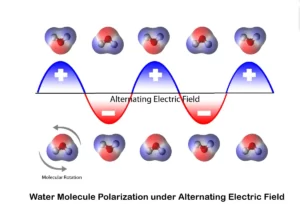Radio frequency (RF) welding, also known as high-frequency (HF) or dielectric sealing, is a process that bonds polymer films using high-frequency electromagnetic energy.
No matter what you call it, the result is the same: clean, consistent seals that fuse materials at the molecular level.
Learn more about RF welding and SealWerks processes below.

A dielectric material is an electrical insulator whose molecules become polarized when exposed to an electromagnetic field. These materials, such as water and certain thermoplastic polymers, contain molecules with positive and negative charges on opposite sides of their structure. Without a field present, the molecules remain randomly oriented.
When subjected to an alternating electromagnetic field, the polar molecules align with it and begin to oscillate in response. This molecular movement produces friction, which, in turn, generates heat throughout the material.
In RF welding, this heating effect allows dielectric polymers to soften and fuse, forming strong, uniform seals. It’s the same principle that makes water heat up in a microwave – just even more controlled and precise for industrial applications.
The entire RF welding process relies on two main components:

The dies, which are typically mounted in a press, form an electric circuit. The upper die carries a positive charge, while the lower acts in the ground. The thermoplastic material placed between them acts as an insulator, allowing energy to build without arcing.
When radio frequency energy is applied, the dielectric polymer heats up internally, melts, and is then cooled under pressure to form a strong, uniform weld.
The upper die is shaped to match the desired weld pattern, whether it’s a straight seam or the outline of a sealed product. The lower die is typically a flat platen, but it may also be contoured to accommodate complex shapes.
Let’s take a closer look at the radio frequency welding process steps:
Material handling can be manual or automated, depending on production needs. In high-speed manufacturing, the entire process can be fully automated for consistent, efficient sealing.
RF weld bonds are shaped by the die rules mounted on the upper die plate. These rules determine both the weld’s form and its structural strength. There are three standard RF welding techniques available, depending on the shape and type of die rule you use.
Plain seam welds use a flat die rule to fuse two or more layers of thermoplastic material. The resulting RF weld is thinner than the combined layers but still functions as an effective insulator, preventing arcing between the dies.
Tear/seal welds use a sharp, knife-edge die to create a thin seam that can be easily torn after welding. This design allows parts to separate cleanly from the surrounding material without secondary cutting. However, the thinner weld increases the risk of die arcing due to minimal insulation between the dies. To prevent damage, operators typically add a non-polar barrier or buffer layer beneath the weld zone.
Combination welds offer greater strength and tearability; a combined die rule blends the tear/seal function with a reinforced outer weld. While this improves durability, it shares the same arcing risk as standard tear/seal welds, requiring a buffer material under the workpiece for protection.



The following materials are all good candidates for RF welding and sealing:
Like any manufacturing process, radio frequency RF welding has its strengths and limitations. For many product manufacturers, RF welding provides precise and reliable sealing for compatible materials. However, it does have constraints related to material type and part design.
Below, we break down the key benefits and challenges of using RF welding for thermoplastics and polymer-based products.
Here’s how RF Welding can benefit your industrial applications tenfold:
Like any material, you’ll also come across some challenges that radio frequency welding comes with. These include the following:
While both radio frequency welding and ultrasonic welding are used to join thermoplastic materials, they rely on entirely different methods to generate the heat required for bonding. In other words, they are not interchangeable.
RF welding uses a high-frequency electromagnetic field to excite the polar molecules within dielectric materials. This molecular movement generates internal friction, which produces heat throughout the material. As the polymer softens, pressure is applied to create a uniform bond once it cools.
Ultrasonic welding, on the other hand, utilizes high-frequency sound waves to generate mechanical vibrations at the interface between two parts. These vibrations cause surface friction between the materials, generating heat directly at the joint.
Both processes locally melt thermoplastic components to form strong molecular bonds. However, RF welding and ultrasonic welding differ in how they generate heat, what materials they can handle, and the types of welds they produce.
Each process requires specific material properties, tooling, and design considerations based on the application.
Radio frequency welding is widely used in industries that require airtight, watertight, or high-strength seals in flexible materials. Its precision and speed make it ideal for producing consistent welds in high-volume manufacturing environments.
Common applications and industries include the following:
Thanks to its ability to create durable, uniform welds without adhesives or stitching, RF welding remains a trusted solution for manufacturers working with dielectric materials across a wide range of sectors.
Whether you’re exploring RF welding for a new product or looking to improve your current manufacturing process, our team at Seal Werks can help. We specialize in custom solutions for a wide range of dielectric materials and industries, from medical and industrial to military and consumer goods.
Have a project in mind? Contact us to discuss your RF welding needs.